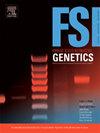从双核酸共提取到共测序:一个高度集成的下一代法医DNA和RNA测序实验工作流程。
IF 3.1
2区 医学
Q2 GENETICS & HEREDITY
引用次数: 0
摘要
DNA和RNA标记在法医实践中具有重要意义,例如个体和体液鉴定。然而,在大多数法医实验中,法医DNA和RNA标记是分开分析的,这导致了大量的样品消耗,程序复杂,证据间相关性弱。虽然已经报道了几种基于毛细管电泳和下一代测序技术的集成方法,但集成方法大多是核酸共提取、共电泳或共测序,并且共同检测的标记数量和类型有限。在这项工作中进行了四项研究,以高度集成的下一代测序工作流程共同分析DNA和RNA。首先,比较了6种商用DNA和RNA共提取试剂盒,选择了两种更适合总核酸提取的试剂盒。其次,研究了总核酸反转录实验方法的可行性,结果表明逆转录反应对用于法医短串联重复和单核苷酸多态性基因分型的DNA片段没有显著影响。第三,建立了DNA和RNA文库的协同制备方法。通过这三项研究,形成了一套高度集成的下一代靶向DNA和RNA测序实验流程,包括DNA和RNA共提取、与总核酸反转录、与基因组DNA和互补DNA共制备文库、共测序和数据分析。第四,为了评估工作流程,我们开发了一个由55个DNA标记(10个常染色体短串联重复序列和45个常染色体单核苷酸多态性)和8个信使RNA标记(2个外周血特异性,4个唾液特异性和2个管家标记)组成的多重面板,并进行了验证实验。DNA基因型和RNA表达结果具有较高的准确性。综上所述,该集成工作流程可用于法医DNA和RNA标记的测序,为在有限的犯罪现场生物材料下全面揭示DNA和RNA生物信息提供了一种有前景的方法。本文章由计算机程序翻译,如有差异,请以英文原文为准。
From dual nucleic acid co-extraction to co-sequencing: A highly integrated next-generation forensic DNA and RNA sequencing experimental workflow
DNA and RNA markers are significant in forensic practices, such as individual and body fluid identification. However, forensic DNA and RNA markers were separately analyzed in most forensic experiments, which resulted in large amounts of sample consumption, complex procedures, and weak inter-evidence correlation. While several integrated methods based on capillary electrophoresis and next-generation sequencing technologies were reported, integrated procedures were mostly on nucleic acid co-extraction, co-electrophoresis, or co-sequencing, and the number and type of markers co-tested were limited. Four studies were conducted in this work to co-analyze DNA and RNA with a highly integrated next-generation sequencing-based workflow. First, six commercial kits for DNA and RNA co-extraction were compared, and two kits more suitable for total nucleic acid extraction were selected. Second, the feasibility of an experimental methodology for reverse transcription with total nucleic acid was investigated, and the results showed that reverse transcription reactions have no significant impact on DNA fragments used for forensic short tandem repeat and single nucleotide polymorphism genotyping. Third, a method for DNA and RNA library co-preparation was developed. Through the three studies, a highly integrated experimental workflow for targeted next-generation DNA and RNA sequencing was developed, including DNA and RNA co-extraction, reverse transcription with total nucleic acid, library co-preparation with genomic DNA and complementary DNA, co-sequencing, and data analysis. Fourth, to evaluate the workflow, we developed a multiplex panel consisting of 55 DNA markers (10 autosomal short tandem repeats and 45 autosomal single nucleotide polymorphisms) and eight messenger RNA markers (two peripheral blood-specific, four saliva-specific, and two housekeeping markers), and carried out validation experiments. High accuracy of DNA genotypes and RNA expression results were observed. Taken together, the novel integrated workflow could be used to sequence forensic DNA and RNA markers, which provides a promising method to comprehensively reveal DNA and RNA bioinformation with limited crime scene bio-materials.
求助全文
通过发布文献求助,成功后即可免费获取论文全文。
去求助
来源期刊
CiteScore
7.50
自引率
32.30%
发文量
132
审稿时长
11.3 weeks
期刊介绍:
Forensic Science International: Genetics is the premier journal in the field of Forensic Genetics. This branch of Forensic Science can be defined as the application of genetics to human and non-human material (in the sense of a science with the purpose of studying inherited characteristics for the analysis of inter- and intra-specific variations in populations) for the resolution of legal conflicts.
The scope of the journal includes:
Forensic applications of human polymorphism.
Testing of paternity and other family relationships, immigration cases, typing of biological stains and tissues from criminal casework, identification of human remains by DNA testing methodologies.
Description of human polymorphisms of forensic interest, with special interest in DNA polymorphisms.
Autosomal DNA polymorphisms, mini- and microsatellites (or short tandem repeats, STRs), single nucleotide polymorphisms (SNPs), X and Y chromosome polymorphisms, mtDNA polymorphisms, and any other type of DNA variation with potential forensic applications.
Non-human DNA polymorphisms for crime scene investigation.
Population genetics of human polymorphisms of forensic interest.
Population data, especially from DNA polymorphisms of interest for the solution of forensic problems.
DNA typing methodologies and strategies.
Biostatistical methods in forensic genetics.
Evaluation of DNA evidence in forensic problems (such as paternity or immigration cases, criminal casework, identification), classical and new statistical approaches.
Standards in forensic genetics.
Recommendations of regulatory bodies concerning methods, markers, interpretation or strategies or proposals for procedural or technical standards.
Quality control.
Quality control and quality assurance strategies, proficiency testing for DNA typing methodologies.
Criminal DNA databases.
Technical, legal and statistical issues.
General ethical and legal issues related to forensic genetics.

 求助内容:
求助内容: 应助结果提醒方式:
应助结果提醒方式:


